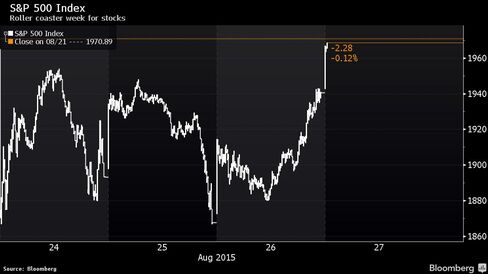U.S. stocks rose, following their biggest gains since 2011, amid a rebound throughout global markets and as data showed the economy grew more than previously estimated.
The Standard & Poor’s 500 Index rose 1.6 percent to 1,970.75 at 9:43 a.m. in New York, after halting on Wednesday its worst six-day plunge in four years. The Dow Jones Industrial Average climbed 228.19 points, or 1.4 percent, to 16,513.70. The Nasdaq Composite Index gained 1.8 percent.
“The economy is in good shape and we’re chugging along at a good pace and that’s good for earnings,” said John Canally, chief economic strategist at LPL Financial Corp. in Boston. “It also should clear some of the noise out of this market. There has been a lot of concern about a slowdown in the economy.”
Data today showed gross domestic product, the value of all goods and services produced, rose at a 3.7 percent annualized rate, exceeding all estimates of economists surveyed by Bloomberg, and up from the 2.3 percent reported last month. Bigger gains in consumer and business spending showed the U.S. expansion getting back on track. A separate report showed filings for jobless benefits declined to a three-week low, indicating persistent demand is encouraging employers to maintain headcounts.
The S&P 500 yesterday trimmed its weekly decline to 1.5 percent and ended a plunge that had erased $2.2 trillion from share values. Dovish words from the Federal Reserve and improving economic data bolstered sentiment that had turned bearish after a global rout triggered by China’s currency devaluation hit American shores.

U.S. stocks wild week continues
Market turmoil sparked by growth concerns has reduced expectations for the Fed to increase interest rates as soon as next month. New York Fed Bank President William Dudley said Wednesday the upheaval has made the case for raising rates in September “less compelling.”
Traders are pricing in a 28 percent chance the central bank will act at its next meeting, down from almost even odds before China’s surprise currency move earlier this month.
China’s Shanghai Composite Index jumped 5.3 percent amid a late-session surge. People familiar with the matter said the government stepped in to boost its stock market, reassuring investors of the state’s support.
“We got a 10 percent pullback and then people realized the fears around China are just fears rather than the reality,” Canally said. “We got our pullback, and now we’re going to focus on U.S. things like GDP and the Fed. When you’re in a correction, it’s not fun, but when you’re out, you can refocus on what matters.”
Investors will seek further clues on an impending rate increase from an annual symposium at Jackson Hole, Wyoming starting today. Central bankers gather there for an academic discussion on inflation just as China’s slowdown renews fears of falling prices. Fed Chair Janet Yellen won’t attend this year.
The Chicago Board Options Exchange Volatility Index fell 13 percent Thursday to 26.41. The measure of market turbulence known as the VIX declined for a third day after a record six-day jump sent the gauge to its highest level since October 2011.
source: Bloomberg
No comments:
Post a Comment